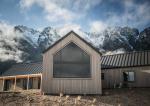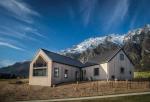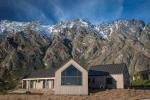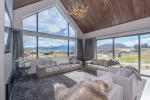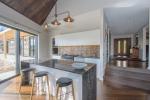Mark Gray: Jacks Point Home
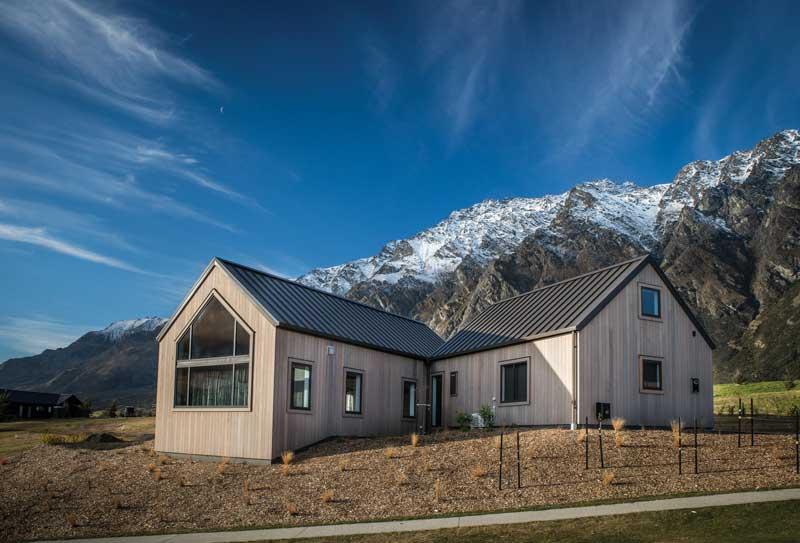
By no means would Jenny and Murray Butler describe themselves as “greenies” but they could both see the sense in building a sustainable, energy-efficient holiday home in Queenstown.
The couple, who live in Auckland, had bought a piece of land in the exclusive Jack’s Point subdivision and took their inspiration for the build from a show home in the area.
They enlisted architect Mark Gray, of Wyatt + Gray Architects, and he suggested they use Evolution homes, which builds energy-efficient homes that are both architecturally beautiful and interesting.
Homes built by Evolution, a division of Rilean Construction, have the potential to reach a minimum of a 6 Homestar rating – ideal for the extreme Central Otago climate.
“When we talked to Mark and Rilean, they explained that in future a star rating would be expected but you can’t do that later; it has to be done now,” says Jenny. “We’re not greenies, so to speak, but we could see it was worth future-proofing the home; we can’t believe how warm it is and the power bills are tiny.” The Butlers have yet to have their house Homestar-rated but plan to have that done soon.
To make the home energy-efficient it has an airtight thermal envelope that ensures maximum warmth with minimum use of resources. The house is double glazed and also benefits from a fully insulated MaxRaft foundation, increased insulation in the exterior walls (R4.2) and ceilings (R5.2), Proclima membranes and hydronic underfloor heating that keep it warm, dry and weathertight with a minimum of condensation. The superior window joinery goes beyond double-glazing and includes argon-gas for better insulation, thermally broken aluminium to minimize condensation and Low E to protect the interior from harmful UV rays.
While those practicalities were taken care of, Jenny and Murray also wanted a home that sat easily within its environment and made the most of the spectacular mountain and lake views.
The 270sq m cedar home with schist detailing and metal tray roofing consists of three gabled pavilions. Design guidelines are tight at Jack’s Point, a 1200ha settlement on the shores of Lake Wakatipu, just 20 minutes outside Queenstown.
There are controls over site placement, building volumes, colours, materials and landscaping – among others. Gabled rooflines are preferred, and garages should not be visible from the road.
One of the elements that the Butlers incorporated into their home was a glazed gable end and this frames views of Jack’s Point golf course and the mountains.“We’ve started calling it ‘The Church’ because of that window,” says Jenny.
The couple also asked Mark to design a home with three bedrooms in one wing, away from the living area, and a fourth bedroom (with en suite) over the garage at the other end of the house. “I also wanted a scullery that I could food prep in behind the kitchen, and I wanted a toilet separate from the main bathroom,” says Jenny.
She says the home’s elevation and the way Mark has oriented it and cleverly placed windows means they get all-day sun and enjoy views from just about every room in the house. “We can seen Jack’s Point golf course, Cecil Peak, Ben Lomond, and we look out over other houses to the southern arm of the lake,” says Jenny. “From the kitchen you can see Fern Hill and the end of Queenstown, and if you look the other way you can see Coronet Peak, which is beautiful in winter when it is all lit up for night skiing and it just sparkles.” She adds, “Even when you are lying in bed in the loft over the garage you can see the top of the Remarkables through the skylight.”
From the street, the crisp lines of the tray roofing complement those of the vertically arranged cedar weatherboards. “A lot of the homes around here have that Alpine Tray roofing because it looks good,” says Jenny. “I like earthy colours; they all have to blend so that is why the house is light and then we have the darker ‘Iron Sand’-coloured roof.”
One of the other striking features of the home – another on the couple’s list – is the glass double doors sitting in an LED-lit, schist-walled entryway before reaching the front door proper. Jenny says, “That means you can come in out of the snow and the rain and shake yourself off before going inside.”
With its high stud and gabled roofline, the home has the “lodgy feel” that the Butlers wanted. “We wanted it all open plan with a big end window and dark-stained French oak on the ceiling.”
Mark Gray says because the section is a fan-shaped corner site there were constraints on how the home could be placed. “With the planning controls, homes are quite often laid out as variations on a ‘U’ or ‘T’ junction,” says Mark. “It made sense to go across the contour with the living and garage, and the living room is on the crank to pick up the contour and face the view.” This arrangement of the pavilions also helps to create a sheltered outdoor area with fire pit.
Mark says Evolution homes are cost-effective for the efficiencies and comfort they deliver. “There’s always a trade-off between performance and budget. For a Homestar-rated home the costs involved can be a bit of a shock and you can build smaller to counter that but if you have a family that is not realistic.” He adds, “The upside is that the houses are pretty easy to run for nine months of the year and just need a little bit of heating in winter.”
Heating in the Butlers’ home is provided by a heat-pump powered hydronic system in the insulated floor slab, with a gas fire for ambience.
Mark says the Jack’s Point design controls that limit buildings to maximum widths and lengths aren’t ideal for energy efficiency because it means “a high wall to floor ratio” that promotes heat loss but that can be countered by placing windows so as to maximise solar gain and minimise heat loss.
With corrugated iron not allowed in the subdivision, Mark says a lot of homeowners have opted for cost-effective Alpine Tray. “As a premium residential neighbourhood, Jack’s Point has tightly defined guidelines in respect of material build and general aesthetics,” he says. “The developers, understandably, have been keen that any new builds on the estate are generally sympathetic to the immediate environment. It’s very much a case of harmoniously blending in, rather than actively standing out.” To achieve this aesthetic, both the architect and homeowners agreed on a COLORSTEEL® Alpine Tray profile, pre-painted in the popular ‘Ironsand’ colour.
Jenny says the one thing that living in an energy-efficient home has taught her is that she has to be careful to dress for the weather. “You get dressed inside in winter thinking it’s warm and then you go outside and it’s freezing,” she says. “When we were planning this home, we wouldn’t have believed how good it is. We’re really thrilled with it.”

